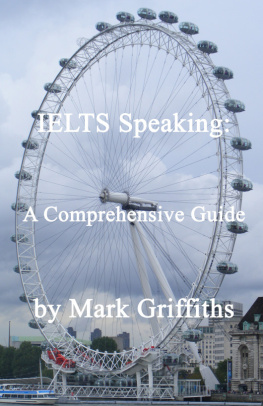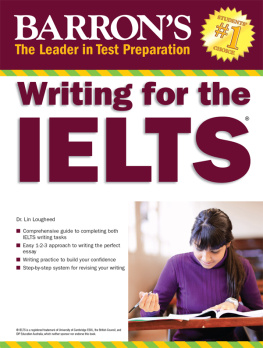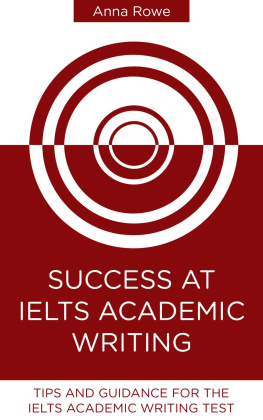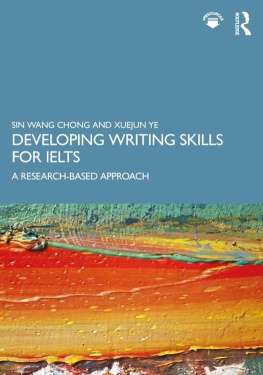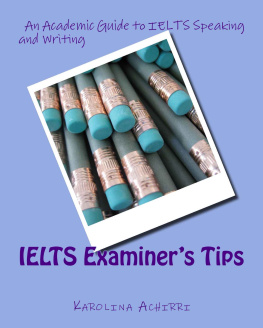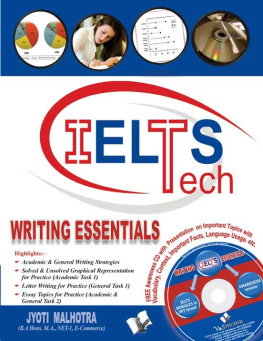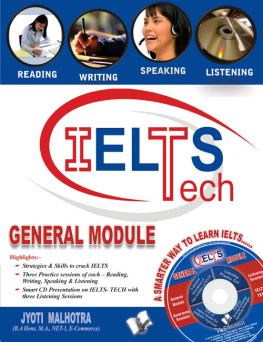IELTS Writing:A Comprehensive Guide
MarkGriffiths
SmashwordsEdition
Copyright 2010Mark Griffiths
Discover othertitles by Mark Griffiths at Smashwords.com
SmashwordsEdition, License Notes
This ebook islicensed for your personal enjoyment only. This ebook may not bere-sold or given away to other people. If you would like to sharethis book with another person, please purchase an additional copyfor each recipient. If youre reading this book and did notpurchase it, or it was not purchased for your use only, then pleasereturn to Smashwords.com and purchase your own copy. Thank you forrespecting the hard work of this author.
Table ofContents
DataQuestions
1. Trafficjams
2. The deathpenalty
3. Governmentspending on the arts
4. Boardingschools
5.Journalists
6. Waste
7. Punishingchildren
8. Animalexperiments
9. Nucleartechnology
10. Schools andsuccess
12.International immigration
13. The statusof women
14. Technologyand traditional cultures
15. Smoking
16. Reportingcrime
17. The future better or worse?
18. Predictingcriminality
19. Faster paceof life
20. Prisons
22. Assessingteachers
23. A globallanguage
24. Childrenfrom wealthy and poor families
25. Shoppingfor leisure
26. Sport andpeace
27. Globaltrade
28.Advertising
29. Using theInternet for education
30. Foodproduction
32. Technologyand creativity
33. Watershortages
34. Theteaching profession
35. Suitablework for women
36. Spending onanimal protection
37. A smallerworld
38. Public orprivate provision of services
39. Tourism andinternational understanding
40. Spaceresearch
42. Work timeand free time
43. Academicand practical school subjects
44. The purposeof schools
45. Privatehealth care
46. Studyinginternational news
47. Male andfemale leaders
48. Modern andtraditional buildings
49. Happinessand economic success
50. Violence infilms
52. Computergames
53. Communityservice
54. Usingcomputers
55. WatchingTV
56. Theavailability of information
57. Workingfrom home
58. Learningtechnical subjects
59 Paying foruniversity studies
60. Theprovision of medical services
62. Gapyears
63. Learningusing computers
64. Defencespending
65. Roadsafety
66. Olderworkers retiring early
67. TheInternet
68. Music
69. Newseditors
70. Careerpaths
72. Taxinghaving children
73. Zoos
74. Cars
75. Diet
76. Urbandevelopment
77. Radio
78. Urban andrural standards of living
79. Governmentspending
80. Thepurposes of museums and art galleries
82. Lying
83. What ishappiness?
84. Fashion
85. Robotstaking over from humans
86. Limitingthe time children spend watching TV
87. Poorstudent behaviour
88. TheInternet and information/development
GeneralIntroduction
Having beeninvolved with IELTS for the past twelve years, I am familiar withthe main problems students face when preparing for the IELTSWriting Module. This book aims to help students deal with theseproblems. The first part of the book examines the format of thewriting module, the assessment criteria, and the common problemsthat students face. It also looks at the requirements of thewriting module in terms of the use of grammar and various parts ofspeech. The second part of the book demonstrates how to writereports, letters, and essays for the IELTS writing module andcontains an extensive range of sample questions and answers.
Introductionfor Teachers (Students should read this, too!)
As a teacher, Iwas eager to produce a book which would be teacher-friendly. Thebook is laid out in such a way that teachers can work through thecontents of the book in the same order that they are presented.
Some basicEnglish structures are presented in the first section of the book.Bear in mind that this is not primarily intended to be a grammarbook and that the grammar and structures contained in the firstsection are really designed to serve as a reminder forstudents.
Dealcomprehensively with the test format and criteria so that studentsknow exactly what they are facing. The first section contains theanswers to questions that students are likely to have. The pagesdevoted to grammar and structures are designed to ensure thatstudents know what level of English is expected of them in thetest.
The threechapters dealing with report, letter, and essay writing approachthe task from the standpoint of a student sitting the examination from understanding the question through to writing theconclusion.
It is unlikelythat you will have enough time to go through all of the essaytopics in the class. This doesn't matter as the essays can easilybe read by students outside class. Students should be encouraged towrite their own answers, using the model essays as guides whereappropriate.
Encouragestudents to be imaginative and thoughtful. The Task 2 topics givestudents plenty of scope for original, highly individual answers.Writing in class gives students the feel of working in a controlledenvironment (particularly with regard to time limits), whereasworking at home allows them to explore new ideas and check newvocabulary. Students should also be encouraged to debate issues.Debating issues before meeting them in the test allows students totest ideas and arguments.
The Format ofthe Writing Module
The format ofthe IELTS Writing Module is very simple. It lasts for 60 minutes.It is strongly recommended that you spend 20 minutes on Task 1 and40 minutes on Task 2. You may do Task 1 first or Task 2 first thechoice is yours. Many candidates prefer to do Task 2 first as it isworth more. Task 2 is worth two-thirds of the total IELTS WritingModule score, with Task 1 being worth one-third. It is vital thatcandidates are aware of how much time they have remaining tocomplete the tasks. Bear in mind that the 60 minutes includes timefor preparation and time for checking your work (e.g. forgrammatical errors and spelling mistakes).
Time is not theonly factor you must bear in mind. Task 1 must be at least 150words long. Task 2 must be at least 250 words long. These are theminimum lengths stated by the test developers. In my experience, aTask 1 report or letter should ideally be around 180 words long,whilst a well-developed Task 2 essay should be around 300 wordslong. Most candidates can achieve these targets without greatdifficulty after a little practise.
The AnswerSheet
Each candidatereceives a four-page answer sheet. Pages 1 and 2 are for Task 1,whilst pages 3 and 4 are for Task 2. Candidates have to write someinformation (name, candidate number, test centre, date, and module)on page 1 before the test begins.
At the bottomof the answer sheet, candidates can see the following:
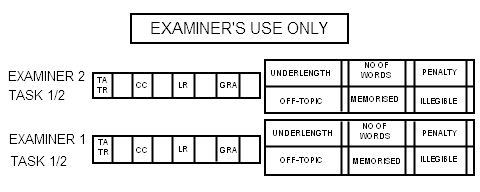
These parts ofthe answer sheet are used by examiners when they assess theanswers. The part where 'Examiner 1' writes scores can be torn offif a second examiner is required to assess the essays. This meansthat the second examiner does not see the scores given by the firstexaminer (and is therefore not influenced by them).
Theabbreviations refer to the criteria (TA = Task Achievement, TR =Task Response, CC = Coherence and Cohesion, LR = Lexical Resource,i.e. vocabulary, and GRA = Grammatical Range and Accuracy).
TaskAchievement (TA) is used in Task 1
Task Response(TR) is used in Task 2
The otherreferences are as follows:
Next page

